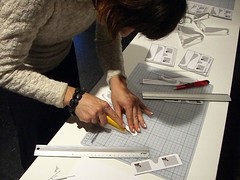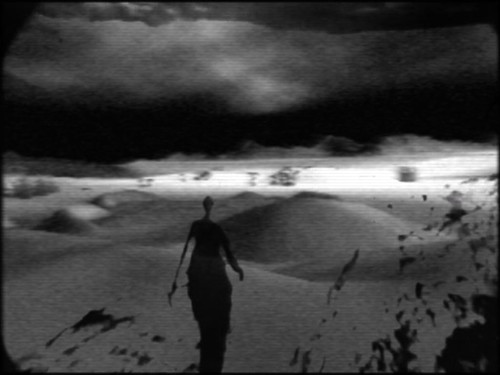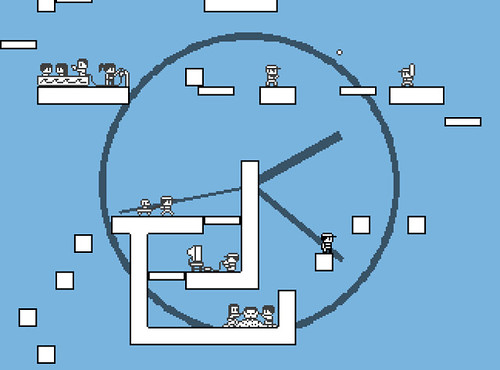Posts with ‘Alexitron’ Tag
Space Invaders: Art in the Computer Game Environment
By: Guest Reviewer
On: February 20th, 2010
[This is a guest article by
Thomas Maxwell-Smith. If you’d like to contribute a guest article to TIGSource, go here.]
Space Invaders: Art in the Computer Game Environment is a not-exactly-overdue attempt at moving on the debacle of a debate that is ‘are video games art’ – from whether the two should share a sentence to whether they should share a room.
Situated across the three New Media-focused gallery spaces of Liverpool’s Fact Cinema, the exhibition seeks to “[explore] the increasingly blurred boundaries between videogame spaces and real spacesâ€, and whilst utterly failing to make any sort of coherent comment on such a thing (what game doesn’t “explore spaceâ€), it’s still a pretty fun look at the benefit of experiencing games beyond the comfort of your living room.
Recessed into a slightly gloomy alcove, the exhibition starts with CuteXdoom II, by Anita Fontaine, the sort of deranged nightmare a techno-obsessed, 4-year-old Tim Burton might have imagined. Based on the Unreal Tournament III engine, it features enough malevolent looking teddy bears dripping in day-glo neon to overlook the fact, as a game, it solely amounts to fetching a few tokens and watching the screen collapse into an (admittedly rather cool) green, pixelated mess.
Exhibited as the winning entry in a competition to make a game based around the theme of ‘art’, And Everything Started To Fall, by Alexitron, is an enjoyable, if predictable, extension of the ‘Profound Indie Game’ template. It combines classic old school game mechanics with social and existential commentary – in this case, the journey through life. Urged by time (the rising screen) into an ever-upward ascent of near impossible 2D precision platforming, you start at birth, jumping though school, work and marriage until ultimately death. Different paths through the game represent different choices in life (e.g. skiving off smoking is an easier route than studying) and the character’s movements slow down in old age. While there are some neat ideas, its place in the exhibition merely highlights the generally naïve, gimmicky approach games take towards presenting meaningful messages.
Oddly, the exhibition doesn’t provide information on how any of the games should be played, and while most are simplistic enough to be relatively accessible for the general audience, Onteca’s Monsteca Corral is impenetrable. Even the pleasant lady paid to stand around being pleasant and helpful couldn’t help. According to Onteca’s website it’s an RTS being released on WiiWare later this year. Hopefully they’ll provide instructions.
The largest space of the exhibition is also the most traditionally ‘art’. COSplayers, by Cao Fei, is a video installation that attempts to illuminate the average life of a typical Chinese Cosplayer beyond their presumably hectic fan convention commitments. Cue shots of grown men with enormous green hair, in leather bondage, eating TV dinners with their Mums. Beyond that is a pixelated video of some people doing parkour (Ludic Society’s Real Play) which completely fails to mention Mirror’s Edge or Cananbalt, some photos of Chinese World of Warcraft sweatshops with some fun pop culture economics about their impact on the game (Chinese Gold by Umbermorgen), and an umbrella that makes terrifyingly loud noises whenever you swing it (Amagatana by Yuichiro Katsumoto), although why you would want to swing it is anyone’s guess.

The room also features mainstream games GTA IV and Fracture, presumably because they let you explore a ‘virtual space’, and Counterstrike, because whenever you’re killed or shot in the game an elaborate looking contraption of blood bags will start leaking down the wall (Riley Harmon’s What It Is Without the Hand That Wields It). Finally, there’s a rather adorable make-and-do section from Aram Bartholl called First Person Shooter, where you construct paper glasses with FPS style guns in the lenses, enabling anyone who wishes to psychotically walk down the street shooting people with their imagination. At last!
The final area features a more eclectic selection of games, the least traditional being LevelHead by Julian Oliver. Like Sony’s interactive card game for PlaystationEye, a camera picks up the movements of a cube you control, with each face appearing on the screen as a level. As you tilt the cube the character inside the cube moves accordingly. It’s a pretty basic puzzle game and the technology is about as advanced as the power light on Project Natal, but it’s also one of the most intriguing and accessible games on display.
Perhaps the best game of the exhibition, Night Journey, by Bill Viola (a non-game artist) and the USC EA (!?) Game Innovation Lab, is a supremely creepy affair dripping with unresolved suspense. Wholly immersed thanks to a projection screen the size of a house, you control some… ‘thing’ crawling painfully slow along the floor, the grainy black and white visuals tearing and bleeding into one another as you explore the barren landscape to no apparent end. There’s even a ‘reflect’ button that triggers ominous noises as you pause to look at things sinisterly! God knows what it’s about, but this needs to be an actual game.
The final highlight, from the generally rather awesome Mark Essen (Messhof), is also the sole game to have been specifically commissioned for the event. Far more subdued than his usual games, Malfunction tasks the player with guiding a astronaut through the gravity-free bowels of a spaceship. The twist is that the playthroughs of past attendees aid you throughout your experience and you work with people you’ve never met to try and beat the game. It’s a fascinating example of how games can be stretched and fitted for a gallery situation. Aside from the aimlessly spinning bodies of the former players, it doesn’t appear to be more than a stylish bit of ambient gaming with a few switch-pushing puzzles thrown in.
Elsewhere, ubiquitous thatgamecompany art game staple Flower is bestowed a peacefully secluded projector for a contemplative experience. Colossal Cave Adventure by William Crowther & Don Woods is a classic text adventure which would probably be totally amazing if only the dialogue options didn’t feel as futile as asking hole in the wall about its holidays. Lastly, a video demonstration of the confusing, and sadly unplayable, Video Terraform Dance Party, by Jeremy Bailey: it shows a city-building game that for some reason ends with the burgeoning metropolis going bankrupt, fruitlessly declaring war on its neighbours and celebrating its demise from an imminent atomic bomb by turning purple and dancing to ’There’s No Limit’. Will Wright take note.
The fact that the most successful games of ‘Space Invaders…’ come from a traditional, non-game, artist (Night Journey), have been created especially for exhibition (Malfunction), and don’t feature a 3rd-party Xbox 360 controller (LevelHead) is telling for this and similar events in the future. Rather than placing ordinary or commercial games on a pedestal, developers should be being challenged to utilize the environments and opportunities afforded by galleries. By engaging, exciting, and surprising the audience, games can deliver something unique to a gallery, opening them up to a whole new audience and invigorating an established one. But for exhibitions like this to truly succeed they shouldn’t be trying to justify today’s games as art, they should be trying to inspire tomorrow’s art to be games. Then maybe, that debacle of a debate might really start to be worth having.
Space Invaders: Art in the Computer Game Environment runs at Fact Liverpool until tomorrow.



